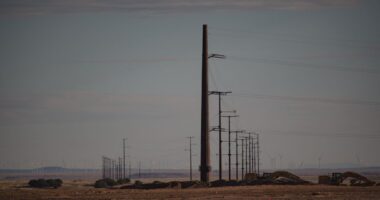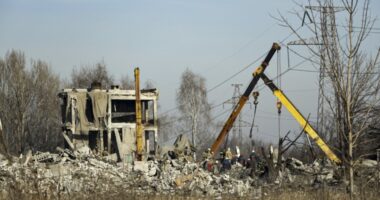
Like the tongue of a snake, Long Island’s eastern edge splits into two distinct tines. To the south lies the cluster of affluent villages known as the Hamptons. To the north is a bucolic strip of farmland that prides itself on its blue-collar roots.
The lines are blurring in recent years, drawn anew by an influx of new residents who fled Manhattan during Covid and never returned. Boutique hotels and craft cocktail bars that cater to them have popped up, and homes are selling for 50 percent more since the pandemic. And in the tiny hamlet of Mattituck, a marina owner now plans to strip a hillside of 600 trees and remove hundreds of millions of pounds of sand to make way for 88 yachts on the edge of the hamlet’s tidal inlet.
Longtime locals see the plan as not just a threat to their fragile coastal environment, but a battle over the character of the entire North Fork of Long Island.
Opponents in this hamlet of fewer than 5,000 people have collected more than 3,000 signatures on a petition against the proposal. “People are starting to cannibalize this place. They want to make it the Hamptons,” said Stephen Boscola, an accountant whose family home sits directly above the site of the proposed development. Their back deck overlooks a forested hillside that will be destroyed if the project continues.
But the marina owner turned developer isn’t a new transplant from Manhattan. He’s one of their own.
Jeff Strong, 66, has lived in Mattituck since he was a boy and is president of Strong’s Marine, a family business that sells boats and operates commercial marinas. Strong’s Marine has been in his family for three generations. He is seeking approval from the area’s planning board to build two massive sheds for indoor yacht storage on the grounds of his yacht center.
Mr. Strong estimates it will cost him more than $5 million to clear the hill, truck out the sand and then build the two 45-foot-tall storage sheds, each around 50,000 square feet. The yacht storage facility, he said, will offer heated indoor winter storage that fills a gap in the market for wealthy boaters from Hamptons communities like Sag Harbor and Amagansett, as well as Westchester County and Connecticut, and will put up to $65,000 in property taxes and $474,000 in sales taxes into the Town of Southold’s coffers each year.
“We’re confident there’s market demand for us to add another 88 yachts, and when it comes to the funding, we could absolutely do both buildings right from the get-go,” Mr. Strong said in an interview at his yacht center. The site currently offers outdoor storage for 15 commercial fishing boats, and both outdoor and unheated indoor storage for up to 100 yachts. He declined to share his current prices, but said he anticipates he will be able to charge at least 25 percent more for heated indoor winter storage.
Locals opposed to the project say wealthy yacht owners from across the sound should find somewhere else to park their vessels in the winter. “We’re creating a North Fork problem for a non-North Fork issue,” said Bridget Elkin, founding agent of Compass Real Estate’s North Fork office. She said that other developers were surely watching, and would be quick to swoop in next if the plan moves forward. “If the planning board is willing to approve projects that don’t benefit the community, it shifts the balance of what people come to the North Fork for,” she added.
Some residents of Mattituck have accused Mr. Strong of a bait-and-switch, suggesting his goal is not long-term profit from the storage of yachts, but immediate gain from the sale of the valuable sand.
High-quality sand is a valuable natural resource that can sell for between $15 and $50 per cubic yard, meaning Strong’s Marine could net between $2 million and more than $6 million after leveling the hillside. When questioned about the potential profit, Mr. Strong said the sand was not worth more than $1.5 million, and he expected the removal and trucking alone to cost him about $1 million. He also points out that much of the sand is not native to the environment; it was placed there in the 1960s by the U.S. Army Corps of Engineers as part of a dredging project on the inlet.
Regardless, excavation of minerals in New York State requires a Mined Land Reclamation Permit, which Mr. Strong does not have. But there is a loophole: Excavations performed as part of construction projects are generally exempt.
“It’s a great way to monetize that hill,” said Mr. Boscola, who has been at the helm of the protests.
Earlier in May, Mr. Boscola and his parents, David and Donna Boscola, donned pins and blue ribbons that signaled their opposition to the project, and joined a packed town-hall meeting that dragged on for nearly four hours. The Town, which encompasses Mattituck, has scheduled a second town hall on the issue for June 5, and is accepting written comments about the project’s potential environmental impact through July 10. The planning board will later make a decision on whether to allow the project to proceed.
Environmentalists worry the project would have a disastrous ricochet effect on natural life in the Mill Road preserve, a 27-acre, taxpayer-funded patch of beech and oak trees that is home to hundreds of deer, birds and other species.
The potential site of the storage sheds abuts the preserve, and though Mr. Strong has promised to plant at least 185 new trees after the hill is leveled, environmentalists say the project would destroy the habitat and invite invasive plants.
“You’re going to have a cascade effect that will come into this public space,” said Louise Harrison, a conservation biologist who works for Save the Sound, a local environmental action group. “This forest was a public investment. And to allow a private individual to destroy a public space seems so grievously wrong.”
Other residents complained that months of 18-wheelers rumbling down the North Fork’s residential roads would disrupt their quality of life.
To Mr. Boscola, whose grandparents built the five-bed, two-and-a-half-bath home that sits in the cross hairs of Mr. Strong’s plans, a proposed development for large yachts on an inlet used daily by clammers and commercial fishermen comes down to the soul of the North Fork.
“Everybody has different concerns. For some people, it’s the trucks. For others, it’s because they appreciate the forest they live next to. But really, I think people are just tired of everybody trying to seize the North Fork,” he said.
Source: | This article originally belongs to Nytimes.com









